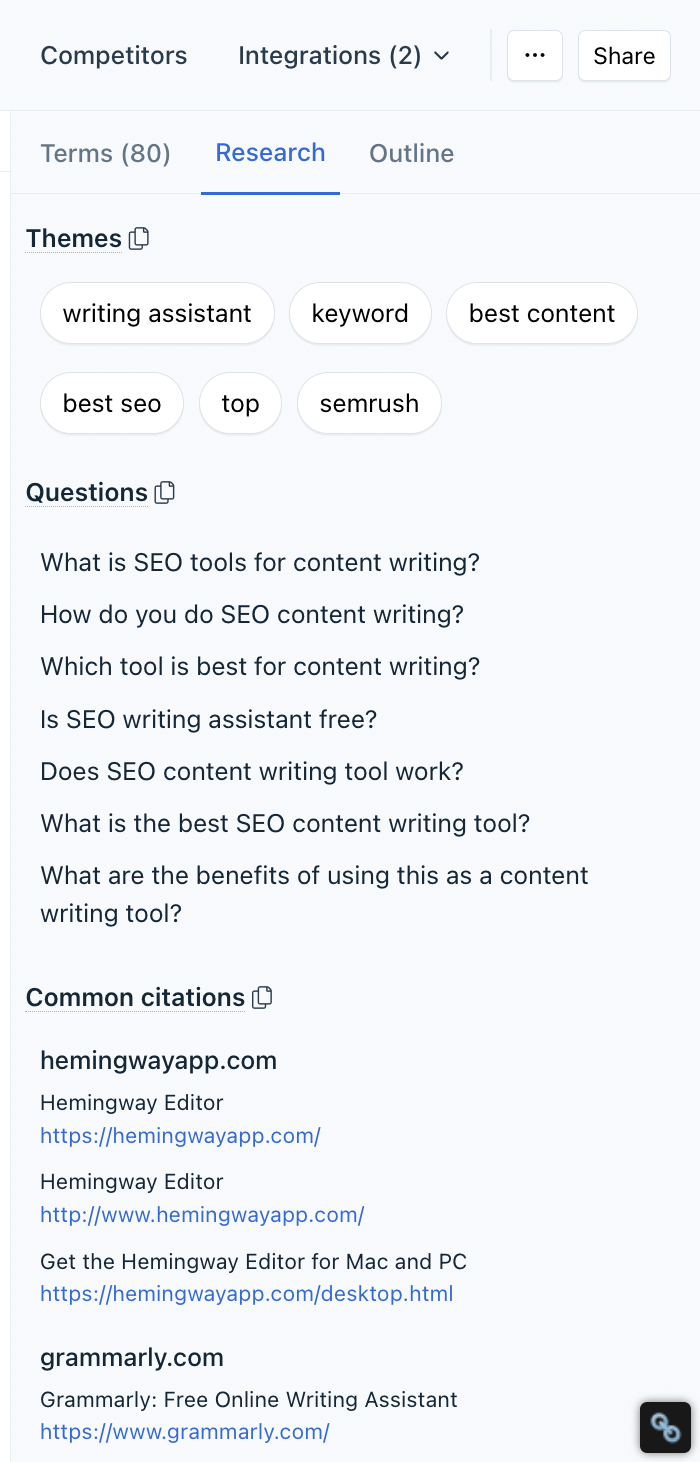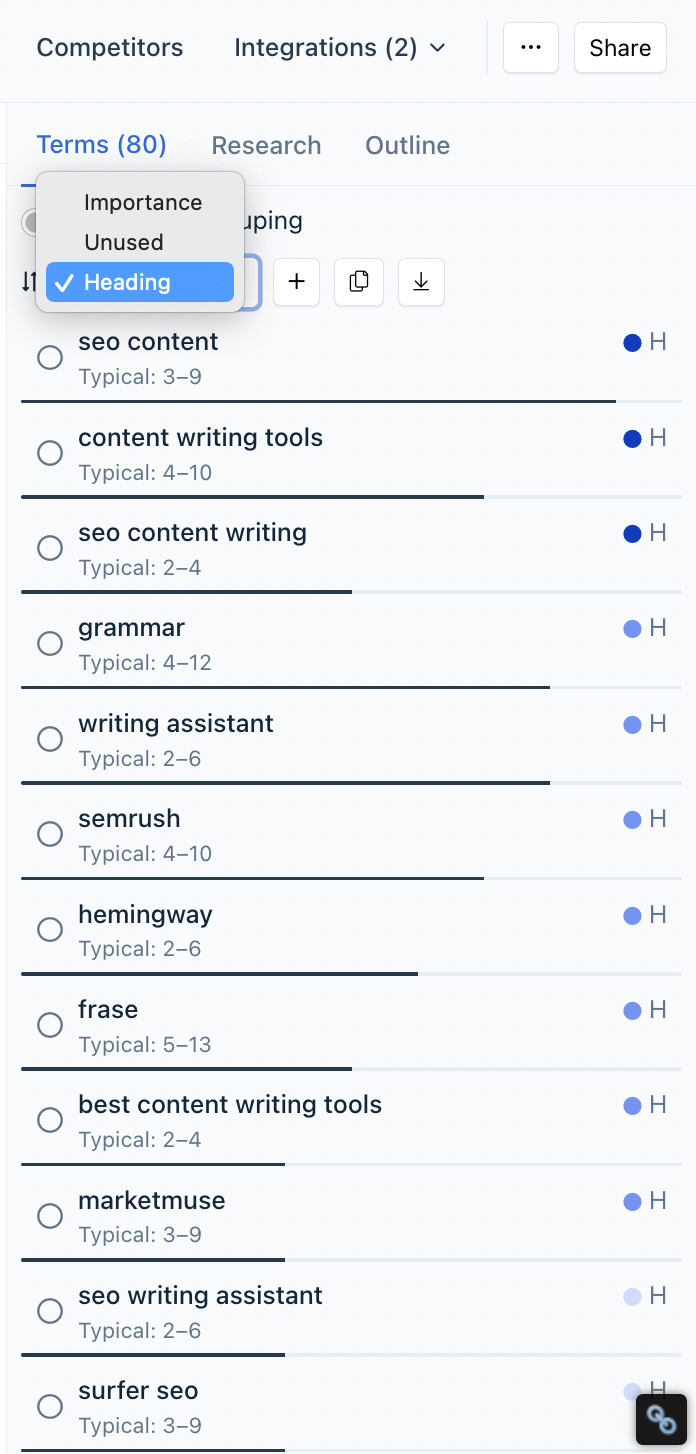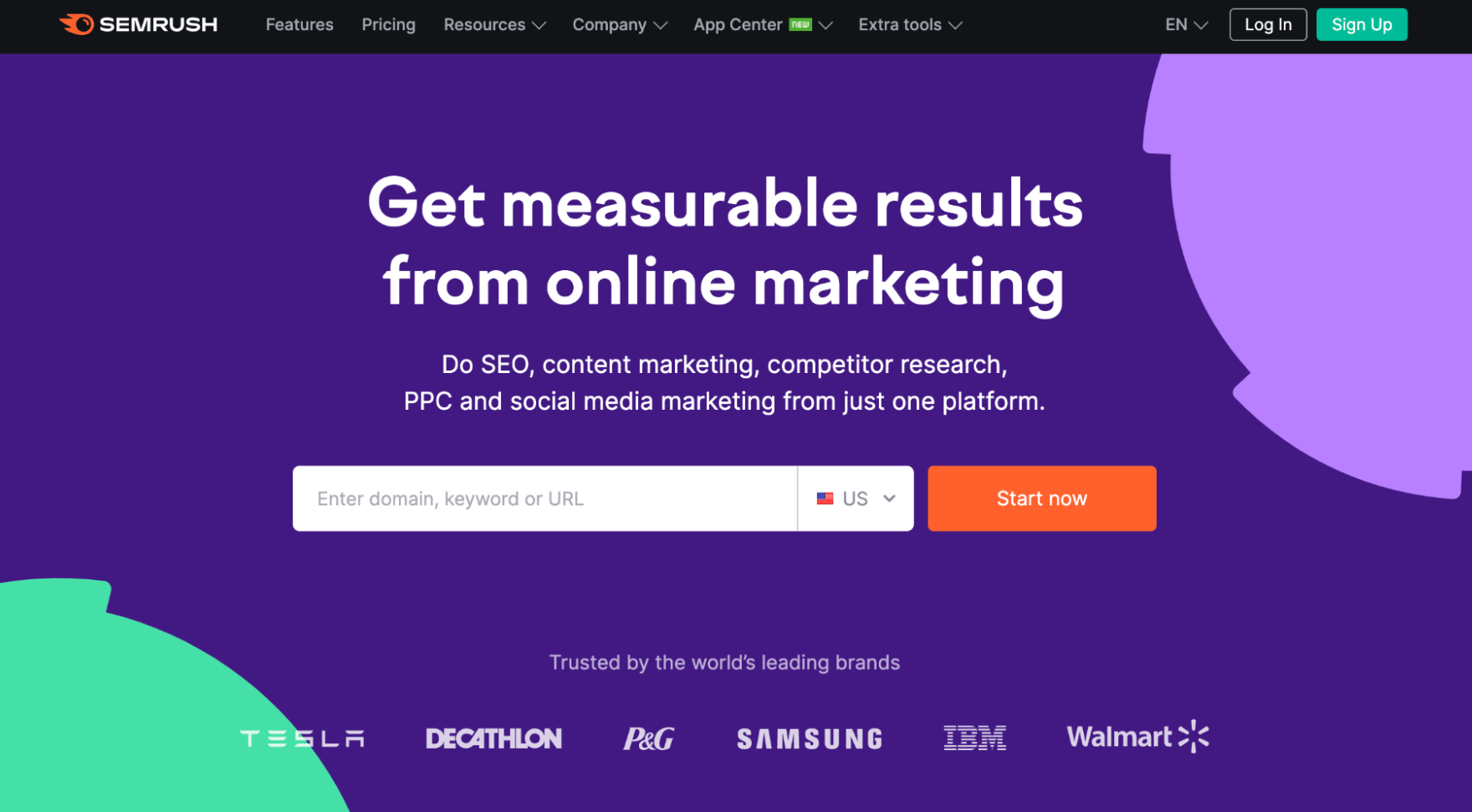SEO Writing: 5 Steps & Tools to Create Top-Ranking Content
Topic: SEO
Published:
Written by: Bernard Huang
“SEO writing” is the practice of creating content with the goal of ranking in the top positions on search engines.
The common misconception with SEO writing is that it’s some highly technical or intricate process — or that as long as you follow “SEO best practices,” you can drop keywords into any ol’ content and rank.
But SEO writing isn’t that prescriptive or straightforward; there’s no secret formula to hit page one or hacks to magically move old (bad) content up the rankings.
If your goal is to create landing pages and blog posts that rank on page one and truly generate new business, you need to write high-quality content that appeals to and engages target audiences (i.e., caters to search intent, offers unique insights), and is optimized for search engines.
Take note of the order there — high-quality content that is also optimized for search engines. Your reader is always your primary audience.
And that’s where teams miss the mark. They focus too much on placing keywords, adding CTAs, or designing other bells and whistles to “improve SEO” — without giving as much consideration to the actual content and the audience receiving it.
Clearscope solves this problem: our SEO drafts provide insights and recommendations to help writers research topics and audiences, perform competitive analysis, build content briefs and outlines, and write high-quality, SEO-friendly content.
They include:
Takeaways from current search results; you can learn about user intent, important themes, common questions related to the search query, and who you’re competing with on page one.
Competitor outlines and suggested headings; you can compare competitor content, “get a lay of the land,” and determine your edge.
A list of terms to use in content so you can optimize (or re-optimize) content without keyword stuffing or guesswork. Each recommendation is unique so you can write SEO content without it sounding overly optimized.
You can reference our SEO drafts while developing your content strategy and write for both audiences — searchers and search engines — naturally.
Our guide walks through the SEO writing process — from researching topics to drafting and monitoring content — in five steps. We’ll show you how Clearscope supports each step so you can get started creating content.
At the end, we’ll also talk about alternative content optimization tools and answer FAQs about SEO content development.
Note: Clearscope is our product. We’re proud of what we’ve built and believe we have the best content optimization and monitoring platform on the market. Request a personalized demo.
1. Perform SERP analysis to learn more about the target keyword
The first step is to research your target keyword and learn more about the topic you’re writing on — as in any normal writing workflow.
The goals at this step include:
Gaining a clear understanding of the topic you’re talking about and the audience you’re writing to.
Getting to the bottom of the audience's goals and search intent. What information are they searching for? Are they shopping for a product or service? What questions are they trying to answer, or what solutions are they looking to find?
Determining what’s already performing well in SERPs and assessing the strengths and weaknesses of competitor content — pay attention to the types of content and websites on page one, take note of featured snippets or recommended products, and review questions in People Also Ask.
Clearscope AI analyzes SERPs to gather a lot of this information for you; then, you can refer to key takeaways in SEO drafts. For example, let’s take a look at the report for the keyword SEO writing tools:

Takeaways from search engine results pages
In the Research tab, you can see: themes from top search results, FAQs, and common citations used in page-one posts. This gives you an idea of the topics to touch on, questions to answer, and links to include.
Then you can tab to Outline and see a list of competitor outlines — we grab these from posts in the top #1-10 positions so you can identify important details to include in your content.
Above, in the Competitors tab, we show you a list of posts ranking in positions #1-30 so you can get a broader idea of who you’re competing with. We show you each page’s title, URL, word count, and current SEO score. This lets you get a general idea of what your content will require to outrank top results.
Then you can move on to step #2.
2. Develop your content strategy & begin building the outline
With the insights from above, you can begin brainstorming ideas for your content (possible titles, your content angle, positioning, etc.). Then, you can determine your strategy for targeting the keyword and how you’ll approach content writing.
The goals at this step include:
Deciding what type of content you’ll produce. Should you create a product page, website resource page, or blog post? (Note: Clearscope Drafts support content writing or SEO copywriting, so you can create long-form content or landing pages with our reports.)
Honing in on the goals and direction of content. What information do you want to cover? How will you answer readers’ questions or solve their problems? What solutions do you plan to promote (if any)?
Developing your content outline. Choose a title for your content and create clear sections with scannable, easy-to-follow headers.
As mentioned, you can reference competitor outlines and check out first-page content to support this step; but Clearscope drafts also show you a list of suggested terms to use in headings, so you can easily brainstorm fresh ideas for content.

Recommended headings and subheadings
Take a look at the list above: you can see important sections to cover (SEO content writing, content writing tools) and even recommended software to include in your post (Semrush, Frase, MarketMuse, etc.).
You can scroll through heading suggestions, see “big picture” ideas, determine your angle for speaking on the topic, and clearly form the foundation of your page or post — without having to question or second guess.
3. Draft content & follow on-page optimization strategies
Now you’re ready to draft your piece of content — but here’s where teams often go astray attempting to “write for SEO.”
The goals at this step include:
Delivering clear, concise information within each section of content.
Ensuring your page or post is readable and scannable — add a table of contents to give readers a preview of content, and use bullet points and strategic bolding to call out important points. Drive value and eliminate fluff.
Incorporating SEO strategies within your natural writing flows — avoid forcing or stuffing keywords — to write high-quality, optimized content.
The important thing to keep in mind (as we’ve stressed throughout) is that you want to approach writing as you would in any other case: write for the reader. Your goals should be to keep audiences on the page, satisfy search intent, and engage readers. Google is your secondary audience.
Fill out each section of your outline with clear, well-rounded information — keep yourself in the reader’s shoes and double-check that you’re providing comprehensive (accurate, current) details from section to section.
If you read back and think that information feels missing or incomplete, you can “fill in.” It’s helpful to drop your own insights or advice, include relevant examples, and talk about topics with a fresh perspective.
One of the most valued ranking factors is content quality: covering these bases as you draft lets you keep the focus on “writing great content,” and this puts you at an advantage, as many other teams get caught up in SEO elements.
Read more: Create Unique Content for Better SEO: 5 Steps (& Tools to Do It)
Clearscope Drafts let writers blend “natural” writing with SEO writing by providing a list of unique terms to include in content. You don’t have to worry about placing (or stuffing) keywords in particular places or risk sounding like a bot.
We put careful consideration into our terms list:
The lists are limited to <100 (usually ~50) terms, so you don’t have literally hundreds of boxes to check.
We include mostly single-term suggestions, so you aren’t tasked with weaving in entire phrases.
We show you the importance of each keyword so you can gauge what’s most significant to content.
We avoid redundancy and repetition, so you aren’t keyword stuffing.
Our platform uses natural language processing (NPL), so you can use variations of the terms on our list and still produce optimized content.

Related keywords to use in content
Drafts show real-time progress as you write and weave in terms — you can monitor your SEO score, word count, and readability grade.
Our drafts even have features to filter like-terms together or show you what’s unused. This makes it easier to include SEO suggestions because you understand what terms relate (we even provide background and examples so you can learn how to talk about topics) and can readily see what you still need to include.

SEO writing in Clearscope
Once you’re done drafting and have achieved the recommended SEO score, you can edit content and follow our checklist below to incorporate the remaining on-page SEO elements.
Note: Drafts highlight used keywords within the content so you can make edits without removing SEO-recommended terms or phrases.
Checklist of on-page SEO elements
Aside from high-quality content, Google considers links, anchor text, in-line media, and alt-text when crawling page content and determining rankings.
Internal links — link to other pages or posts on your site that relate to content. This creates a connection between the pieces of content, which helps build authority and improves the user experience.
External links — you should include at least one of these in content — link to other credible sites that talk about the same topic. The citations in Clearscope Drafts can help you gather ideas for these links, but many teams choose to link the resources they reference during their research because it makes the most sense for the reader’s journey. Just double-check that you’re linking to sites with high DAs so Google sees you’re recommending authoritative sites.
Anchor text — the anchor text you use to place links should be clear and indicative of where the link is directing readers. (It’s also good practice to anchor keywords where possible.) You can’t just place links over any related text for the sake of including a link; readers may follow links, realize the content is not what they were expecting or interested in, and drop off (which does more harm than good).
Visuals — everybody knows readers enjoy images, infographics, and other supporting media within content; it breaks up the copy and provides greater context when explaining more complex ideas. But Google looks for these, too. Relevant (optimized) media gives Google more context about page content to determine the overall quality and helpfulness.
Alt-text with in-line media — continuing on the last point, alt-text with media gives Google even more context about page content. But these are also beneficial in other ways. They provide a description of media so users can see what’s included in content in the event media doesn’t load. It also improves accessibility, which supports SEO; users with assisted readers can still gather important takeaways from media. Check out some of the alt-text below the images in this post as examples.
You can also follow our guide, 10-Step Checklist for SEO Content Editing, for more tips on reviewing and finalizing content.
4. Publish & promote content
Once content has the green light, you’re ready to publish and begin promotion. This is fairly straightforward, but here are some action items to consider at this step:
Draft strategic SEO title tags & meta descriptions. These are the titles and descriptions that appear in search engines, so you want them to be enticing and attention-grabbing; however, you should also use keywords in titles. You add these elements within the CMS, so you can plug titles and descriptions and give content another look-over before hitting publish.
Build backlinks to content. Links from other sites help Google see that others recommend you. If you establish link building relationships on authoritative sites (in relevant content and with clear anchors), you can improve your authority in the space and earn higher rankings.
Promote content through other digital marketing efforts, like email newsletters, social media, and PPC campaigns. These drive readers to content before it achieves top rankings, so you can start measuring how content performs with audiences and show Google you have valuable information for readers.
Remember: Poor engagement metrics can have an adverse effect on content rankings — which is, again, why content quality and writing for your audiences is of utmost importance.
Then, we recommend reporting on content performance and promotional strategies to see:
Where content ranks and how rankings change; you can see if rankings decline and measure the rate of progression as URLs move toward page one.
How content performs in SERPs; you can measure click-through rates, check bounce rates, and analyze traffic sources to learn how audiences find content.
If content achieves the goals you set for it — for example, if you want to increase sales for a particular product or service via content, you can measure conversion rates to see which content pieces actually drive new business.
Current SEO scores; see how content compares to current SERP results and plan updates to uphold page-one rankings.
You can learn more about monitoring website content here — 5 SEO Monitoring Tools | Track Website & Content Performance — but we’ll talk more about tracking and refreshing content for SEO below.
5. Monitor & refresh SEO content
It goes without saying that you can’t just publish content and expect it to remain on page one indefinitely — all content requires updates to remain competitive. The timing of updates is mostly “up to guess” if you don’t have a method to monitor content; that’s where Clearscope Content Inventory comes into play.
Here are some goals for this step:
Keep track of what you have published so you can avoid overlap when scheduling new keywords.
Track content SEO scores so you can plan updates before you notice rankings or traffic decline.
Identify and troubleshoot low-ranking or underperforming posts.
Clearscope Content Inventory lets you save web pages with target keywords to check real-time SEO scores. You can add an unlimited number of URLs to this dashboard and monitor all of the content that lives on your site.

Clearscope Content Inventory dashboard
You can refer to this dashboard at any time to see the most current SEO score. Then, you can plan updates for posts with low or declining content grades; the goal of this SEO tool is to help you refresh content before rankings or traffic decline — then you’re less troubleshooting and more maintaining content.
Plus, you can use Clearscope Drafts to guide the updates. Run a new draft for the target keyword, paste your content, and follow our recommendations to re-optimize.
Read more: Best Practices for Updating Website Content (2023 Guide)
Staying on top of content helps you see the best ROI from all content creation — new posts, old posts, blog content, product pages, etc.
Best tools for SEO writing: Clearscope & alternatives
Although we consider Clearscope the best content optimization tool, there are a handful of other SEO writing tools we commonly hear about from customers or see in software review guides.
We’ve gathered feedback on these tools so you can review their main features, pros, and cons.
Semrush

Semrush digital marketing software
Semrush is a name most people know because they offer a comprehensive digital marketing solution with tools to support a variety of tasks (SEO writing, backlink management, social media management, local SEO, the list goes on). Teams that already use Semrush for other purposes often try their SEO Writing Assistant, as it’s included in most packages.
The most common piece of feedback we hear is that the SEO Writing Assistant isn’t super in-depth — reports provide high-level insights on how to position and outline content, but the more detailed recommendations are usually obvious and not super helpful. For example, the term lists basically include the keyword and variations of it.
So that’s not to say you can’t use Semrush’s content writing tool at all; it just may not be the most helpful during the more strategic stages of content development (like editing and finalizing content).
If you already use Semrush, this is worth checking out; but if you’re looking to invest in a dedicated content optimization tool, you may feel disappointed by Semrush’s offering.
Surfer

Surfer tools for content marketing strategy
Surfer is a content optimization tool with features to help you:
Create new optimized content with SEO reports (like Clearscope).
Audit and re-optimize existing site content.
However, their strengths lie in the latter — their Grow Flow dashboard is one of their most popular tools (what they’re known for) because it delivers personalized insights to help you see better ROI from what’s already on your site.
This tool is most popular amongst teams that have a high volume of existing site content and want advice on where/how to start making improvements. Reports include insights on pages to update, internal and external links, how to optimize media, and more.
Surfer doesn’t earn the best reviews when it comes to creating new optimized content because their reports can be a little hard to use: they include hundreds of term suggestions, terms are often repetitive (which leads to keyword stuffing), and the platform doesn’t usually understand variations of terms.
You essentially have to follow reports to a T to achieve the desired SEO score — but in many cases, you have to compromise content quality and stuff in terms in order to reach that score.
In summary, if you’re looking for advice on SEO best practices and want to focus on improving existing site content, Surfer could be a great fit. But if your focus is on new content creation, it’s not the strongest solution.
Frase

Frase SEO content writer
Frase is a content optimization platform with SERP research tools and an AI writer to generate SEO-optimized content — it’s popular amongst teams that are interested in using AI technology to streamline content production.
Although AI writers are handy in many circumstances, we have our reservations about them when it comes to SEO writing. Here’s why: these tools can accurately write about popular, well-known topics (they basically analyze what’s ranking on the SERP and spit out a new version of it), and they can follow SEO best practices to optimize content. However, they cannot generate unique ideas or “write something new.”
As such, writing loses that human touch; it doesn’t contain fresh insights, personal opinions or advice, or real-life examples — all of the things that help connect with and engage readers. And if you consider what we’ve been stressing about engagement and content quality, you can see how this could prevent you from achieving top rankings.
Frase’s AI writer may be useful for other types of content creation — say promotional or “viral” content that you aren’t writing for the purpose of ranking. But if your goal is to produce new, unique, engaging, thought-leadership-style content; sell particular products or services in content; have specific goals for content, then you’re better to develop this content with the help of SEO reports.
All in all, we’re not saying Frase offers a poor solution, we just recommend using AI tools strategically — you can still leverage Frase’s SERP research tools to outline and draft optimized content without using the AI writer.
FAQs on SEO writing
What’s the difference between on-page and off-page SEO?
On-page SEO is everything you include in content (on the actual page) to improve the reader experience and appeal to Google’s algorithm. This includes internal and external links, in-line media, and alt-text.
Off-page SEO refers to what goes on “off the page” to promote content. One go-to example of off-page SEO is backlinks — when other sites link back to your content. Backlinks from authoritative, credible, already-ranking sites boost your content’s authoritativeness and performance in search engines.
You can update page content to enhance on-page SEO, and you can adjust promotional strategies to improve off-page SEO.
How often should you re-optimize website content?
There is no golden rule on how often to update content — but it’s safe to say most content is due for a refresh after nine to twelve months (around the year mark).
The best way to tell when content is due for updates is to monitor SEO scores; these tell you how well content compares to other SERP results. Then, you can refresh content if scores change and maintain page-one rankings.
What is the importance of SEO writing?
SEO writing is important because it improves your visibility in organic search results, which helps content perform in the short and long term — even if you’re not putting resources into promotion. Optimizing content for search engines means it can be continually found by readers interested in the topic (now and into the future).
Pushing content to the top of page one has additional benefits: you can increase organic traffic, which can lead to conversions and better rankings. Plus, top-ranking content can bring new visitors to your site — those that don’t already follow you on social media or subscribe to your newsletter — and grow your user base.
Read more: How Long Does It Take to Rank In Google with SEO Techniques?
Start creating SEO-friendly content
Clearscope is an easy-to-use content optimization platform with packages for individuals, small teams, and enterprise users — our solution includes keyword research tools, interactive SEO reports, and a real-time Content Inventory to support each phase of content development.
All of our users have access to the same core features, and we provide complementary training and onboarding for beginner SEOs still learning the ropes.

On-Page SEO Checkers to Audit Site SEO & Write Optimized Content (2023)
In this guide, we review two types of on-page SEO checkers: solutions to audit page SEO and real-time reports to create new, optimized website content.
Read moreHow to Get On the First Page of Google SERP: 8 SEO Strategies
We review the best SEO strategies to produce high-quality content & get on the first page of Google search results. See how Clearscope supports your teams.
Read moreWhat is SEO value and why it matters
Understand what SEO value is, how it’s calculated, its key metrics, and how it can demonstrate the ROI of SEO in your digital marketing efforts.
Read more